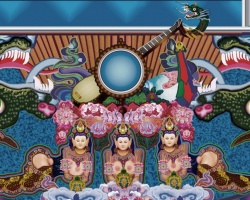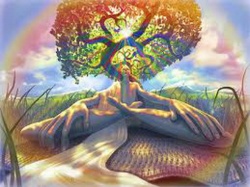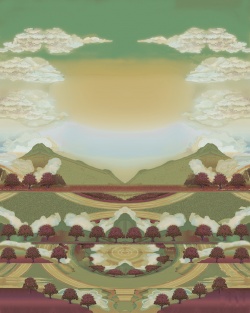Difference between revisions of "Balkh & Khorasan (Sun Coming)"
| Line 1: | Line 1: | ||
{{DisplayImages|376|1008|1362}} | {{DisplayImages|376|1008|1362}} | ||
| − | ''Italic text''[[Khorasan]], also written as [[Khurasan]], ({{Wiki|Persian}}: خراسان بزرگ or خراسان کهن) is a historical region {{Wiki|lying}} in the [[northeast]] of {{Wiki|Persia}} that has been mentioned in various sources in the {{Wiki|past}}. "In pre-Islamic and early {{Wiki|Islamic}} times, the term "Khurassan" frequently had a much wider denotation, covering also parts of {{Wiki|Central Asia}} and {{Wiki|Afghanistan}}; early {{Wiki|Islamic}} usage often regarded everywhere [[east]] of {{Wiki|western}} {{Wiki|Persia}}, sc. Djibal or what was subsequently termed 'Irak 'Adjami, as being included in a vast and ill-defined region of [[Khurasan]], which might even extend to the {{Wiki|Indus}} Valley and Sind." Before Islamization of the region, the inhabitants of [[Khorasan]] had mostly practiced {{Wiki|Zoroastrianism}} but at different stages there were also various {{Wiki|adherents}} of {{Wiki|Manichaeism}}, {{Wiki|Sun}} worshippers ([[Wikipedia:Mithraic Mysteries|Mithraism]]), {{Wiki|Nestorianism}}, {{Wiki|Paganism}}, [[Shamanism]], [[Buddhism]] and a small number of [[Jews]] too....Khorasan in its proper [[sense]] comprised principally the cities of Mashhad, Nishapur, Sabzevar and Kashmar (now in {{Wiki|Iran}}), Balkh and Herat (now in {{Wiki|Afghanistan}}), Merv, Nisa and Abiward (now in {{Wiki|Turkmenistan}}), Samarqand and Bukhara (now in [[Uzbekistan]]). | + | |
| + | |||
| + | |||
| + | |||
| + | |||
| + | |||
| + | |||
| + | |||
| + | |||
| + | |||
| + | ''Italic text''[[Khorasan]], also written as [[Khurasan]], ({{Wiki|Persian}}: خراسان بزرگ or خراسان کهن) is a historical region {{Wiki|lying}} in the [[northeast]] of {{Wiki|Persia}} that has been mentioned in various sources in the {{Wiki|past}}. "In pre-Islamic and early {{Wiki|Islamic}} times, the term "Khurassan" frequently had a much wider denotation, covering also parts of {{Wiki|Central Asia}} and {{Wiki|Afghanistan}}; early {{Wiki|Islamic}} usage often regarded everywhere [[east]] of {{Wiki|western}} {{Wiki|Persia}}, sc. Djibal or what was subsequently termed 'Irak 'Adjami, as being included in a vast and ill-defined region of [[Khurasan]], which might even extend to the {{Wiki|Indus}} Valley and Sind." Before Islamization of the region, the inhabitants of [[Khorasan]] had mostly practiced {{Wiki|Zoroastrianism}} but at different stages there were also various {{Wiki|adherents}} of {{Wiki|Manichaeism}}, {{Wiki|Sun}} worshippers ([[Wikipedia:Mithraic Mysteries|Mithraism]]), {{Wiki|Nestorianism}}, {{Wiki|Paganism}}, [[Shamanism]], [[Buddhism]] and a small number of [[Jews]] too....Khorasan in its proper [[sense]] comprised principally the cities of Mashhad, Nishapur, Sabzevar and Kashmar (now in {{Wiki|Iran}}), [[Balkh]] and Herat (now in {{Wiki|Afghanistan}}), Merv, Nisa and Abiward (now in {{Wiki|Turkmenistan}}), Samarqand and [[Bukhara]] (now in [[Uzbekistan]]). | ||
The [[name]] "[[Khorasan]]" is derived from Middle {{Wiki|Persian}} [[khor]] (meaning "{{Wiki|sun}}") and [[asan]] (or ayan literally meaning "to come" or "coming" or "about to come"), hence meaning "land where the {{Wiki|sun}} rises". The {{Wiki|Persian}} [[word]] Khāvar-zamīn ({{Wiki|Persian}}: خاور زمین), meaning "the [[eastern land]]", has also been used as an {{Wiki|equivalent}} term. | The [[name]] "[[Khorasan]]" is derived from Middle {{Wiki|Persian}} [[khor]] (meaning "{{Wiki|sun}}") and [[asan]] (or ayan literally meaning "to come" or "coming" or "about to come"), hence meaning "land where the {{Wiki|sun}} rises". The {{Wiki|Persian}} [[word]] Khāvar-zamīn ({{Wiki|Persian}}: خاور زمین), meaning "the [[eastern land]]", has also been used as an {{Wiki|equivalent}} term. | ||
{{DisplayImages|}} | {{DisplayImages|}} | ||
| − | [[Khorasan]] ({{Wiki|Persian}}: استان خراسان) (also transcribed as [[Khurasan]] and [[Khorassan]], anciently called Traxiane during {{Wiki|Hellenistic}} and [[Wikipedia:Parthian Empire|Parthian]] times) currently names a region located in [[north]] eastern {{Wiki|Iran}}, but historically referred to a much larger area [[east]] and north-east of the {{Wiki|Persian Empire}}. The [[name]] [[Khorasan]] is {{Wiki|Persian}} and means "where the {{Wiki|sun}} arrives from." The [[name]] was given to the eastern province of {{Wiki|Persia}} during the Sassanid [[Empire]]. | + | [[Khorasan]] ({{Wiki|Persian}}: استان خراسان) (also transcribed as [[Khurasan]] and [[Khorassan]], anciently called Traxiane during {{Wiki|Hellenistic}} and [[Wikipedia:Parthian Empire|Parthian]] times) currently names a region located in [[north]] eastern {{Wiki|Iran}}, but historically referred to a much larger area [[east]] and north-east of the {{Wiki|Persian Empire}}. The [[name]] [[Khorasan]] is {{Wiki|Persian}} and means "where the {{Wiki|sun}} arrives from." The [[name]] was given to the eastern province of {{Wiki|Persia}} during the [[Sassanid]] [[Empire]]. |
[[Khorasan]] was originally inhabited by the {{Wiki|ancient}} Indo-Iranians in the Bactria–Margiana {{Wiki|Archaeological}} Complex in around 2000 BC. The BMAC was a Bronze Age {{Wiki|culture}} situated in the upper [[Amu Darya]] region of [[Khorasan]]. Airyanem Vaejah (Land of [[Aryans]]), which is mentioned in the {{Wiki|Zoroastrian}} [[Avesta]], is also believed by some [[scholars]] to be situated in the territories of [[Khorasan]]. | [[Khorasan]] was originally inhabited by the {{Wiki|ancient}} Indo-Iranians in the Bactria–Margiana {{Wiki|Archaeological}} Complex in around 2000 BC. The BMAC was a Bronze Age {{Wiki|culture}} situated in the upper [[Amu Darya]] region of [[Khorasan]]. Airyanem Vaejah (Land of [[Aryans]]), which is mentioned in the {{Wiki|Zoroastrian}} [[Avesta]], is also believed by some [[scholars]] to be situated in the territories of [[Khorasan]]. | ||
| − | Before the Balkh region fell to [[Wikipedia:Alexander the Great|Alexander the Great]] in 330 BC, it was part of the Achaemenid [[Empire]] and prior to that it was occupied by the Medes. Following Alexander's brief {{Wiki|occupation}}, the successor state of the Seleucid [[Empire]] controlled the area until 305 BCE when they gave [[south]] of the [[Hindu]] Kush to the [[Indian]] {{Wiki|Maurya Empire}} as part of an alliance treaty...."Alexander took these away from the [[Aryans]] and established settlements of his own, but Seleucus Nicator gave them to Sandrocottus ([[Chandragupta]]), upon terms of intermarriage and of receiving in exchange 500 [[elephants]]." —{{Wiki|Strabo}}, 64 BC – 24 AD | + | Before the [[Balkh]] region fell to [[Wikipedia:Alexander the Great|Alexander the Great]] in 330 BC, it was part of the [[Achaemenid]] [[Empire]] and prior to that it was occupied by the Medes. Following [[Alexander's]] brief {{Wiki|occupation}}, the successor [[state]] of the Seleucid [[Empire]] controlled the area until 305 BCE when they gave [[south]] of the [[Hindu]] Kush to the [[Indian]] {{Wiki|Maurya Empire}} as part of an alliance treaty...."Alexander took these away from the [[Aryans]] and established settlements of his [[own]], but Seleucus Nicator gave them to Sandrocottus ([[Chandragupta]]), upon terms of intermarriage and of receiving in exchange 500 [[elephants]]." —{{Wiki|Strabo}}, 64 BC – 24 AD |
Traxiane....Modern Damghan. City in the [[Wikipedia:Parthian Empire|Parthian]] district of Traxiana, later known as [[Khorasan]]. It has been occupied since prehistoric times and was the original capital of the {{Wiki|ancient}} province of Qumis. | Traxiane....Modern Damghan. City in the [[Wikipedia:Parthian Empire|Parthian]] district of Traxiana, later known as [[Khorasan]]. It has been occupied since prehistoric times and was the original capital of the {{Wiki|ancient}} province of Qumis. | ||
| Line 14: | Line 24: | ||
Khwarezm has been known also as Chorasmia, Khwarezmia, Khwarizm, Khwarazm, Khorezm, Khoresm, Khorasam, Harezm, Horezm, and Chorezm. C.E. Bosworth however, believes the {{Wiki|Persian}} [[name]] to be made up of (خور) meaning "the {{Wiki|sun}}" and (زم) meaning "[[Earth]]", designating "the land from which the {{Wiki|sun}} rises"..... | Khwarezm has been known also as Chorasmia, Khwarezmia, Khwarizm, Khwarazm, Khorezm, Khoresm, Khorasam, Harezm, Horezm, and Chorezm. C.E. Bosworth however, believes the {{Wiki|Persian}} [[name]] to be made up of (خور) meaning "the {{Wiki|sun}}" and (زم) meaning "[[Earth]]", designating "the land from which the {{Wiki|sun}} rises"..... | ||
| − | Khwarezm and neighboring Bactriana were part of the Sassanid [[empire]] | + | Khwarezm and neighboring [[Bactriana]] were part of the [[Sassanid]] [[empire]] |
Successive cultures in Khwarzem region 3000-500 BC.... Keltiminar {{Wiki|Culture}} c. 3000 BC..... Suyargan {{Wiki|Culture}} c 2000 BC..... Tazabag’yab {{Wiki|Culture}} c. 1500 BC...... Amirabad {{Wiki|Culture}} c 1000 BC..... [[Saka]] c. 500 BC..... During the final [[Saka]] phase, there were about 400 settlements in Khwarzem | Successive cultures in Khwarzem region 3000-500 BC.... Keltiminar {{Wiki|Culture}} c. 3000 BC..... Suyargan {{Wiki|Culture}} c 2000 BC..... Tazabag’yab {{Wiki|Culture}} c. 1500 BC...... Amirabad {{Wiki|Culture}} c 1000 BC..... [[Saka]] c. 500 BC..... During the final [[Saka]] phase, there were about 400 settlements in Khwarzem | ||
Latest revision as of 09:07, 30 March 2024
Italic textKhorasan, also written as Khurasan, (Persian: خراسان بزرگ or خراسان کهن) is a historical region lying in the northeast of Persia that has been mentioned in various sources in the past. "In pre-Islamic and early Islamic times, the term "Khurassan" frequently had a much wider denotation, covering also parts of Central Asia and Afghanistan; early Islamic usage often regarded everywhere east of western Persia, sc. Djibal or what was subsequently termed 'Irak 'Adjami, as being included in a vast and ill-defined region of Khurasan, which might even extend to the Indus Valley and Sind." Before Islamization of the region, the inhabitants of Khorasan had mostly practiced Zoroastrianism but at different stages there were also various adherents of Manichaeism, Sun worshippers (Mithraism), Nestorianism, Paganism, Shamanism, Buddhism and a small number of Jews too....Khorasan in its proper sense comprised principally the cities of Mashhad, Nishapur, Sabzevar and Kashmar (now in Iran), Balkh and Herat (now in Afghanistan), Merv, Nisa and Abiward (now in Turkmenistan), Samarqand and Bukhara (now in Uzbekistan).
The name "Khorasan" is derived from Middle Persian khor (meaning "sun") and asan (or ayan literally meaning "to come" or "coming" or "about to come"), hence meaning "land where the sun rises". The Persian word Khāvar-zamīn (Persian: خاور زمین), meaning "the eastern land", has also been used as an equivalent term.
Khorasan (Persian: استان خراسان) (also transcribed as Khurasan and Khorassan, anciently called Traxiane during Hellenistic and Parthian times) currently names a region located in north eastern Iran, but historically referred to a much larger area east and north-east of the Persian Empire. The name Khorasan is Persian and means "where the sun arrives from." The name was given to the eastern province of Persia during the Sassanid Empire.
Khorasan was originally inhabited by the ancient Indo-Iranians in the Bactria–Margiana Archaeological Complex in around 2000 BC. The BMAC was a Bronze Age culture situated in the upper Amu Darya region of Khorasan. Airyanem Vaejah (Land of Aryans), which is mentioned in the Zoroastrian Avesta, is also believed by some scholars to be situated in the territories of Khorasan.
Before the Balkh region fell to Alexander the Great in 330 BC, it was part of the Achaemenid Empire and prior to that it was occupied by the Medes. Following Alexander's brief occupation, the successor state of the Seleucid Empire controlled the area until 305 BCE when they gave south of the Hindu Kush to the Indian Maurya Empire as part of an alliance treaty...."Alexander took these away from the Aryans and established settlements of his own, but Seleucus Nicator gave them to Sandrocottus (Chandragupta), upon terms of intermarriage and of receiving in exchange 500 elephants." —Strabo, 64 BC – 24 AD
Traxiane....Modern Damghan. City in the Parthian district of Traxiana, later known as Khorasan. It has been occupied since prehistoric times and was the original capital of the ancient province of Qumis.
Khwarezm has been known also as Chorasmia, Khwarezmia, Khwarizm, Khwarazm, Khorezm, Khoresm, Khorasam, Harezm, Horezm, and Chorezm. C.E. Bosworth however, believes the Persian name to be made up of (خور) meaning "the sun" and (زم) meaning "Earth", designating "the land from which the sun rises".....
Khwarezm and neighboring Bactriana were part of the Sassanid empire
Successive cultures in Khwarzem region 3000-500 BC.... Keltiminar Culture c. 3000 BC..... Suyargan Culture c 2000 BC..... Tazabag’yab Culture c. 1500 BC...... Amirabad Culture c 1000 BC..... Saka c. 500 BC..... During the final Saka phase, there were about 400 settlements in Khwarzem
In Avestan the name is Xvairizem, in Old Persian Huwarazmish, in Modern Persian خوارزم (Khwārazm), in Arabic خوارزم Khwārizm, in Old Chinese Hūsìmì (呼似密), modern Chinese Huālázǐmó (花剌子模), in Uzbek Xorazm, in Greek Χορασμία and Χορασίμα, by Herodotus.
This research explores my understanding that historically and geographically, the 'legendary' Kingdom of Shambhala was located in the region of Shamis en Balkh (Sham-i-Bala, Bactra, Zariasta)....the great ancient city in Bactria (a region possibly known as Tagzig, Oddiyana, Olmo Lungring) and the great rich and fertile region surrounded by the Pamir and Hindu Kush Mountains.


